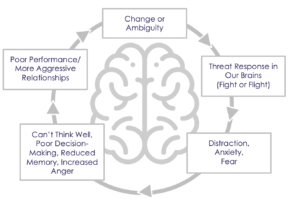Resistance to change is significant. Our brains are hot-wired to keep us from changing because we are built to avoid risk and danger. Consider the illustration below – when facing a time of change we become distracted, make poor decisions and become more aggressive. Our ‘fight’ mode has been activated.
For leaders, we have the opportunity to lead ourselves, lead the business and lead others through change. We must first begin with clarity on how our brain functions and how we personally handle or respond to change. This self-awareness should help us be more aware of how our behavior is impacting others.
Consider the following set of questions to assess your capability as a leader during a time of change –
Leading Self –
- What is your view of change?
- How does your own anxiety impact your ability to navigate change?
Leading Others –
- In your business, does everyone have a voice for the change initiative? In other words, have they been heard? This does not mean they get to vote on what to do, but rather they have been heard about what is about to happen.
- What is your process for implementing the new business change?
Leading the Business –
- What is the strategic objective of the change initiative?
- How clear is your vision regarding the change?
- In terms of a formula for change consider the following – Dissatisfaction + Vision + Process > Cost (Of Change)
Every decision has a cost associated with it. It is important that you know the cost. Consider this equation, dissatisfaction plus your vision plus your process must be greater than the cost associated with the change.

